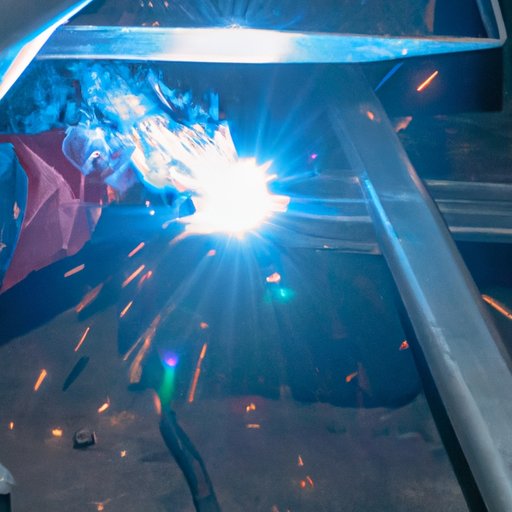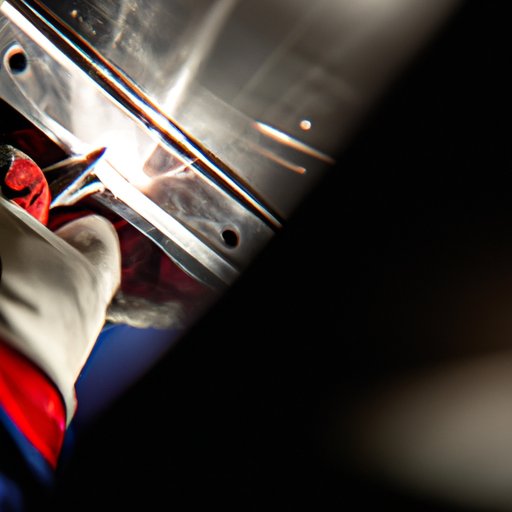
Introduction
Importance of understanding the process of welding aluminum to steel
Aluminum and steel are commonly used metals in various applications that require high strength and durability. Welding both metals together is advantageous in numerous industrial applications, as it allows for the creation of more robust structures. However, welding aluminum to steel requires a careful process of preparation and techniques to ensure the right bond is created. Understanding the process is vital to ensuring a successful outcome and preventing structural weakening or damage.
Basic definitions and concepts of the welding process
Welding is the process of joining two or more metal components by heating them to their melting point and allowing them to cool and fuse together. Fusion welding, as it is commonly known, is performed in various ways depending on the metal type, joint type, and application. Welding techniques generally involve the use of an external heating source such as electric arc, laser, gas flame, friction, and ultrasonic equipment to help join the two metal parts to form a permanent bond.
Overview of the article’s main points
This article explores the technicalities of welding aluminum to steel and the challenges associated with it. It covers the science- the need to know before engaging in the process – factors that influence the quality of the weld and strategies to overcome challenges during the process. It also delves into the techniques and best practices for welding aluminum to steel, common mistakes, frequently asked questions and answers, as well as advanced welding techniques and emerging technologies.
The Technicalities of Welding Aluminum to Steel: Understanding the Process
Types of welding techniques and processes applicable to aluminum and steel
There are several welding techniques used in various applications, including arc welding, MIG welding, TIG welding, and spot welding. The welding technique used to join aluminum to steel differs from the standard welding process because the two metals have different chemical and metallurgical properties that affect the fusion of the joint.
The science behind welding dissimilar metals
Welding dissimilar metals involves joining two metal parts with different mechanical properties, melting points, and electrical conductivity. In welding, the electrode material should be selected based on the metal combination to ensure that the melting points are compatible and conducive to fusion welding. Welding dissimilar metals poses numerous technical challenges, including cracking, warping, and porosity.
Factors that affect the welding process
Several factors influence the welding process, including the types of metal being used, joint design, welding position, weld speed, and temperature. Controlling these factors determined by the welding process and welding materials is essential in ensuring the creation of a high-quality weld and preventing stresses that can lead to distortion, cracking, or deformation of the joint.
Pre-welding preparations and procedures
Pre-welding preparation is crucial and involves cleaning the surfaces to be welded, positioning the metal pieces in the right orientation, and ensuring that the welding equipment is in the right condition. Pre-welding procedures include fitting, tack welding and joint design.
From Dissimilar Metals to Bonding: Welding Aluminum to Steel
Understanding the properties and characteristics of aluminum and steel
Steel is an alloy made of iron and carbon, which typically has a melting point of 1370 degrees Celsius. In contrast, aluminum is a lightweight metal with a much lower melting point of 660 degrees Celsius. The differences in melting temperature make welding the two metals together a bit more complicated than welding steel or aluminum alone.
Finding the right welding technique for bonding aluminum to steel
The proper welding technique for welding aluminum to steel depends on the thickness, the shape of the components, and the joint design. The most common welding techniques used for welding the two metals together include friction welding, explosion welding, and brazing.
Techniques for creating a strong bond between aluminum and steel
Creating a strong bond requires managing the difference in melting temperatures between the two metals to ensure that they fuse properly. The techniques used to ensure a strong bond include selecting the appropriate electrode material, using adhesives, and avoiding extended exposure to high temperatures, which can weaken the strength of the connection.
The importance of metal compatibility in achieving a strong connection
The success of welding aluminum to steel depends on the compatibility of the two metals, and the welding technique used. Metals that are incompatible can lead to poorly welded joints, loss of joint strength, or complete joint failure. Welders must carefully select welding equipment and materials that are compatible with both types of metals being welded to ensure a strong connection.
Challenges and Solutions: How to Weld Aluminum to Steel
Challenges that occur during the welding process
Welding aluminum to steel is a complex process that can be fraught with numerous challenges. For example, the two metals have different melting points, thermal expansion coefficients, electrical conductivity, and corrosion resistance. Mechanical tensions can also occur, which can lead to cracks and distortion if not properly managed.
Strategies for overcoming welding challenges
Several strategies can help reduce the challenges of welding aluminum to steel, including choosing the right welding technique and equipment, minimizing the heat input, and controlling the weld pool size, speed and position. Welders must also pay heed to post-welding procedures and cleaning and inspection procedures.
Techniques for minimizing distortion and preventing cracks
Preventing distortion and cracks requires careful planning and execution of the welding process, including proper preparation, right technique selection and ensuring the right electrode and filler materials are chosen. Additional techniques include preheating, clamping and fixture arrangements to avoid mechanical stresses and deformation caused by the welding process.
Tips and tricks for successful welding
Increased expertise and experience come with complex techniques and procedures required for welding aluminum to steel. Tips to help welders achieve better results, including the need for proper cleaning and drying techniques to prevent contamination and the importance of proper pre and post-welding procedures. Welders must also ensure the work area is clean, tidy and adequately ventilated to protect from harmful fumes.
Welding Aluminum to Steel: Making Strong and Durable Connections
Achieving a strong and reliable connection between aluminum and steel
Effective bonding between aluminum and steel requires expertise in the welding technique used as the two metals require specific requirements for effective bonding. Proper attention must be given to choosing the appropriate welding technique, understanding the properties of the materials being joined, and avoiding the pitfalls of welding dissimilar metals.
Factors that contribute to the durability of the welded joint
The durability of the welded joint is influenced by the quality of the weld, the materials selected, and the pre and post-weld preparation performed. Adequately selected electrodes, adhesives, and welding equipment can significantly contribute to the welded joint’s longevity, reducing the chances of failure, and ensuring a strong weld bond.
The importance of weld quality and inspection
The quality of the weld is critical and requires careful inspection after the welding process. Welds may have internal and external faults that can be identified through testing. Performing quality checks after welding means assessing the structural strength, joint penetration, surface finish, and weld depth, which help to ensure the weld is of the highest quality possible.
Techniques for improving joint strength
Several techniques assist in improving the joint strength, including using the correct epoxy or adhesive material, making use of clamping and increasing the weld bead size by using appropriate welding wire sizes. Proper joint design, machine setup and argon shielding gas use also significantly improve joint strength and durability.
What You Need to Know About Welding Aluminum to Steel
Safety protocols to follow during the welding process
The welding process exposes the welder to numerous hazards, including intense heat, spatter, fumes, and ultraviolet light. To guarantee the welder’s safety, personal protective equipment such as welding gloves, helmets, and jackets must be worn. Proper ventilation, equipment maintenance, and periodic maintenance checks also help to minimize risks.
Advantages and disadvantages of welding aluminum and steel
The advantages and disadvantages of welding aluminum and steel include the additional strength and durability it provides, the ability to join different metals to match the application needs, and the resistance to corrosion and other environmental factors that impair structural integrity. The disadvantages include the challenge of welding dissimilar metals, the cost of welding equipment, and the need for careful preparation and planning to ensure high-quality welds.
Tips for selecting the right welding materials
Choosing the right welding materials is essential to ensuring a high-quality weld. Factors to consider include the work environment, strength requirements, the type of materials to be welded, and the welding technique to be used. Welders should choose welding materials that are compatible and have a low melting point, opt for tech materials with a CTE to match, and consider the corrosion resistance of materials.
Frequently asked questions and answers
Common FAQs include the type of welding materials needed for aluminum to steel, the best welding technique, how to choose the welding equipment, whether to use a laser or TIG welding technique, and what factors influence the weld quality. The article offers comprehensive answers to these and other common questions.

Beyond the Limits: Successfully Welding Aluminum to Steel
Advanced techniques for welding aluminum and steel
Advanced techniques for welding aluminum and steel include Hybrid laser-Arc welding, friction stir welding, and cold metal transfer welding. Such techniques offer increased precision, efficiency, and quality of the joint, and eliminate the need for any post-weld cleaning and preparing procedures.
Examples of real-life applications of welding aluminum to steel
Welding aluminum to steel has a wide range of applications in different industries, including the aerospace, automotive, and manufacturing industries. The process is used to form parts that require high strength, durability, and consistency in physical properties. In the aerospace industry, the technique is used to make aircraft wings, while in the automotive industry, it is used to make auto bodies that are lightweight and strong.
The future of welding technology and its impact on welding dissimilar metals
Automated welding technology, advances in material science, and 3D welding technology are expected to revolutionize the welding of dissimilar metals. Welding aluminum to steel, which is perceived as a challenging and complex task, will become even easier. Technological advancements will increase efficiency and quality in the welding process, while reducing the cost of welding equipment and the chances of joint failure.
Conclusion and final thoughts
Welding aluminum to steel is a process that requires careful planning, preparation and execution. Understanding the science, the difference in properties, the welding techniques and other important factors makes it simpler. Welding aluminum to steel using the right technique makes it possible to join the two metals to create a robust structure that is efficient, durable, and long-lasting. Follow the tips, best practices, and techniques discussed in this article, and you will increase the chances of successfully welding aluminum to steel.





